Types of Psychoactive Drugs
 Flip It Video: Neurotransmitters and Drugs
Flip It Video: Neurotransmitters and Drugs
The three major categories of psychoactive drugs are depressants, stimulants, and hallucinogens. All do their work at the brain’s synapses, stimulating, inhibiting, or mimicking the activity of the brain’s own chemical messengers, the neurotransmitters.
Depressants
Depressants are drugs such as alcohol, barbiturates (tranquilizers), and opiates that calm neural activity and slow body functions.
Alcohol
True or false? Alcohol is a depressant in large amounts but is a stimulant in small amounts. False. In any amount, alcohol is a depressant. Low doses of alcohol may, indeed, enliven a drinker, but they do so by acting as a disinhibitor — they slow brain activity that controls judgment and inhibitions. Alcohol is an equal-opportunity drug: It increases (disinhibits) helpful tendencies — as when tipsy restaurant patrons leave extravagant tips and social drinkers bond in groups (Fairbairn & Sayette, 2014; Lynn, 1988). And it increases harmful tendencies, as when sexually aroused men become more disposed to sexual aggression. One University of Illinois campus survey showed that before sexual assaults, 80 percent of the male assailants and 70 percent of the female victims had been drinking (Camper, 1990). Another survey of 89,874 American collegians found alcohol or drugs involved in 79 percent of unwanted sexual intercourse experiences (Presley et al., 1997). When drinking, both men and women are more disposed to casual sex (Claxton et al., 2015; Johnson & Chen, 2015). The bottom line: The urges you would feel if sober are the ones you will more likely act upon when intoxicated.
The prolonged and excessive drinking that characterizes alcohol use disorder can shrink the brain (Figure 25.1). Women, who have less of a stomach enzyme that digests alcohol, are especially vulnerable (Wuethrich, 2001). Girls and young women can become addicted to alcohol more quickly than boys and young men do, and they are at risk for lung, brain, and liver damage at lower consumption levels (CASA, 2003).
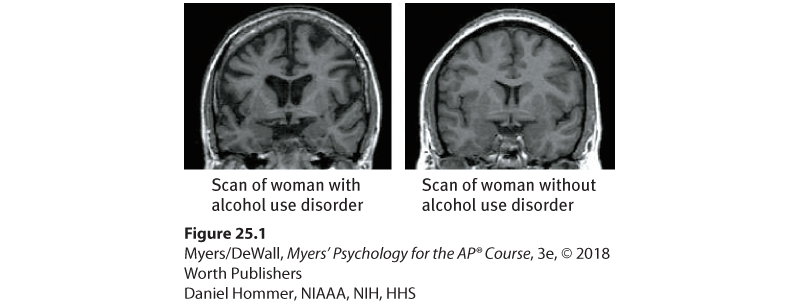
Figure 25.1 Disordered drinking shrinks the brain
MRI scans show brain shrinkage in women with alcohol use disorder (left) compared with women in a control group (right).
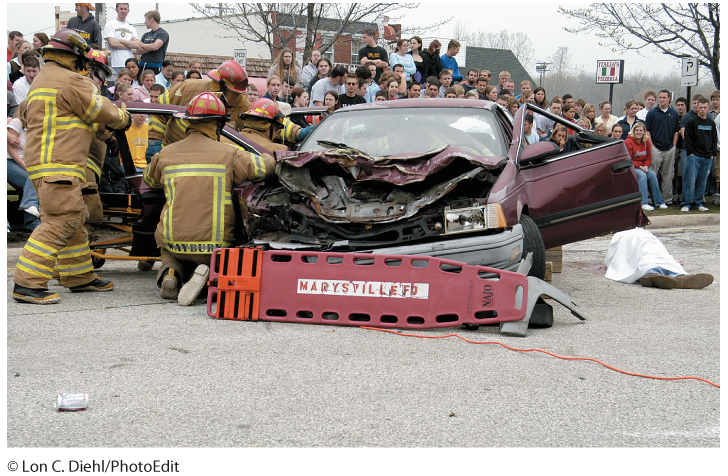
Drinking disaster demo Firefighters reenacted the trauma of an alcohol-related car accident, providing a memorable demonstration for these high school students. Alcohol consumption leads to feelings of invincibility, which become especially dangerous behind the wheel of a car.
SLOWED NEURAL PROCESSING
Alcohol slows sympathetic nervous system activity. In low doses, it relaxes the drinker. In larger doses, it causes reactions to slow, speech to slur, and skilled performance to deteriorate. Paired with sleep deprivation, alcohol is a potent sedative. Add these physical effects to lowered inhibitions, and the result can be deadly. Worldwide, several hundred thousand lives are lost each year in alcohol-related accidents and violent crime. As blood-alcohol levels rise and judgment falters, people’s qualms about drinking and driving lessen. When drunk, people aren’t aware how drunk they are (Moore et al., 2016). In experiments, virtually all drinkers who had insisted when sober that they would not drive under the influence later decided to drive home from a bar, even if given a Breathalyzer test and told they were intoxicated (Denton & Krebs, 1990; MacDonald et al., 1995). Alcohol can be life threatening when heavy drinking follows an earlier period of moderate drinking, which depresses the vomiting response. People may poison themselves with an overdose that their bodies would normally throw up.
MEMORY DISRUPTION
Alcohol can disrupt memory formation, and heavy drinking can also have long-term effects on the brain and cognition. In rats, at a developmental period corresponding to human adolescence, binge drinking contributes to nerve cell death and reduces the birth of new nerve cells. It also impairs the growth of synaptic connections (Crews et al., 2006, 2007). In humans, heavy drinking may lead to blackouts, in which drinkers are unable to recall people they met the night before or what they said or did while intoxicated. These blackouts result partly from the way alcohol suppresses REM sleep, which helps fix the day’s experiences into permanent memories.
REDUCED SELF-AWARENESS
In one experiment, those who consumed alcohol (rather than a placebo beverage) were doubly likely to be caught mind-wandering during a reading task, yet were less likely to notice that they zoned out (Sayette et al., 2009). Sometimes we mind-wander to give our brains a break, but unintentional zoning out — while driving, for example — can cause later regret, especially if we’ve endangered ourselves or others (Seli et al., 2016). Alcohol not only reduces self-awareness, it also produces a sort of “myopia” by focusing attention on an arousing situation (say, provocation) and distracting it from normal inhibitions and future consequences (Giancola et al., 2010; Hull & Bond, 1986; Steele & Josephs, 1990).
Reduced self-awareness may help explain why people who want to suppress their awareness of failures or shortcomings are more likely to drink than are those who feel good about themselves. Losing a business deal, a game, or a romantic partner sometimes elicits a drinking binge.
EXPECTANCY EFFECTS
As with other psychoactive drugs, expectations influence behavior. Expectations help explain why adolescents — presuming that alcohol will lift their spirits — sometimes drink when they’re upset and alone. Solitary drinking actually does not boost mood, but it does increase the likelihood of developing a substance use disorder (Creswell et al., 2014; Fairbairn & Sayette, 2014).
Simply believing we’re consuming alcohol can cause us to act out alcohol’s presumed influence (Christiansen et al., 2016; Moss & Albery, 2009). In a now-classic experiment, researchers gave Rutgers University men (who had volunteered for a study on “alcohol and sexual stimulation”) either an alcoholic or a nonalcoholic drink (Abrams & Wilson, 1983). (Both had strong tastes that masked any alcohol.) After watching an erotic movie clip, the men who thought they had consumed alcohol were more likely to report having strong sexual fantasies and feeling guilt-free. Being able to attribute their sexual responses to alcohol released their inhibitions — whether or not they had actually consumed any alcohol.
So, alcohol’s effect lies partly in that powerful sex organ, the mind. Fourteen “intervention studies” have educated college drinkers about that very point (Scott-Sheldon et al., 2014). Most participants came away with lower positive expectations of alcohol and reduced their drinking the ensuing month.
Barbiturates
Like alcohol, the barbiturate drugs, or tranquilizers, depress nervous system activity. Barbiturates such as Nembutal, Seconal, and Amytal are sometimes prescribed to induce sleep or reduce anxiety. In larger doses, they can impair memory and judgment. If combined with alcohol — as sometimes happens when people take a sleeping pill after an evening of heavy drinking — the total depressive effect on body functions can be lethal.
Opiates
The opiates — opium and its derivatives — also depress neural functioning. Opiates include heroin and also medically prescribed pain-relief narcotics, such as codeine, morphine, and methadone (a synthetic opiate sometimes prescribed as a heroin substitute). As blissful pleasure replaces pain and anxiety, the user’s pupils constrict, breathing slows, and lethargy sets in. Those who become addicted to this short-term pleasure may pay a long-term price: a gnawing craving for another fix, a need for progressively larger doses (as tolerance develops), and the extreme discomfort of withdrawal. When repeatedly flooded with an artificial opiate, the brain eventually stops producing endorphins, its own opiates. If the artificial opiate is then withdrawn, the brain will lack the normal level of these painkilling neurotransmitters. In recent years, more and more people have been unable or unwilling to tolerate this state and have paid an ultimate price — death by overdose (CDC, 2015).
Stimulants
A stimulant excites neural activity and speeds up body functions. Pupils dilate, heart and breathing rates increase, and blood sugar levels rise, causing a drop in appetite. Energy and self-confidence also rise.
Stimulants include caffeine, nicotine, and the more powerful cocaine, amphetamines, methamphetamine (“speed”), and Ecstasy (which is also a mild hallucinogen). People use stimulants to feel alert, lose weight, or boost mood or athletic performance. Some students may resort to stimulants in hopes of boosting their academic performance. Unfortunately, such stimulants offer only modest benefits (Ilieva et al., 2015). Stimulants can also be addictive, as you may know if you are one of the many who use caffeine daily in your soda, energy drinks, coffee, or tea. Cut off from your usual dose, you may crash into fatigue, headaches, irritability, and depression (Silverman et al., 1992). A mild dose of caffeine typically lasts three or four hours, which — if taken in the evening — may impair sleep.
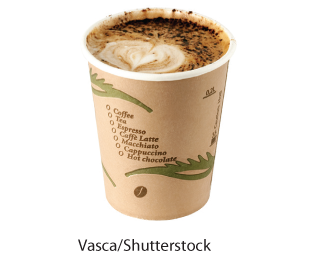
Nicotine
Cigarettes, e-cigarettes, and other tobacco products deliver highly addictive nicotine. Imagine that cigarettes were harmless — except, once in every 25,000 packs, an occasional innocent-looking one is filled with dynamite instead of tobacco. Not such a bad risk of having your head blown off. But with 250 million packs a day consumed worldwide, we could expect more than 10,000 gruesome daily deaths (more than three times the 9/11 terrorist fatalities each and every day) — surely enough to have cigarettes banned everywhere.1
The lost lives from these dynamite-loaded cigarettes approximate those from today’s actual cigarettes. A teen-to-the-grave smoker has a 50 percent chance of dying from the habit, and each year, tobacco kills nearly 5.4 million of its 1.3 billion customers worldwide. (Imagine the outrage if 25 loaded jumbo jets crashed today, let alone tomorrow and every day thereafter.) By 2030, annual tobacco deaths are expected to increase to 8 million. That means that 1 billion twenty-first-century people may be killed by tobacco (WHO, 2012).
Tobacco products include cigarettes, cigars, chewing tobacco, pipe tobacco, snuff, and — most recently — e-cigarettes. Inhaling the vapor of e-cigarettes (“vaping”) gives users a jolt of nicotine without cancer-causing tar. As a result, their sale has boomed: Between 2011 and 2013, youth e-cigarette use tripled (Arrazola et al., 2015; Noland et al., 2016). But there is a downside: E-cigarettes deliver toxic chemicals and can increase one’s chances of using conventional cigarettes (Barrington-Trimis et al., 2016; Farsalinos et al., 2014). And e-cigarettes seem not to help current smokers quit, as companies sometimes claim (Wang et al., 2015).
Smoke a cigarette and nature will charge you 12 minutes — ironically, just about the length of time you spend smoking it (Discover, 1996). (Researchers don’t yet know how e-cigarette smoking affects life expectancy.) Compared with nonsmokers, smokers’ life expectancy is “at least 10 years shorter” (CDC, 2013). Eliminating smoking would increase life expectancy more than any other preventive measure. Why, then, do so many people smoke?
“ Smoking cures weight problems . . . eventually.”
Comedian-writer Steven Wright
Tobacco products are powerfully and quickly addictive. Attempts to quit even within the first weeks of smoking often fail (DiFranza, 2008). As with other addictions, smokers develop tolerance, and quitting causes withdrawal symptoms, including craving, insomnia, anxiety, irritability, and distractibility. Nicotine-deprived smokers trying to focus on a task experience a tripled rate of mind wandering (Sayette et al., 2010). When not craving a cigarette, they tend to underestimate the power of such cravings (Sayette et al., 2008).
All it takes to relieve the aversive state of a cigarette craving is a single puff. Within 7 seconds, a rush of nicotine will signal the central nervous system to release a flood of neurotransmitters (Figure 25.2). Epinephrine and norepinephrine will diminish appetite and boost alertness and mental efficiency. Dopamine and opioids will temporarily calm anxiety and reduce sensitivity to pain (Ditre et al., 2011; Gavin, 2004). No wonder ex-smokers will sometimes, under stress, return to smoking — as did some 1 million Americans after the 9/11 terrorist attacks (Pesko, 2014). Ditto for people with major depressive disorder, who are more likely than others to see their efforts to quit go up in smoke (Zvolensky et al., 2015).
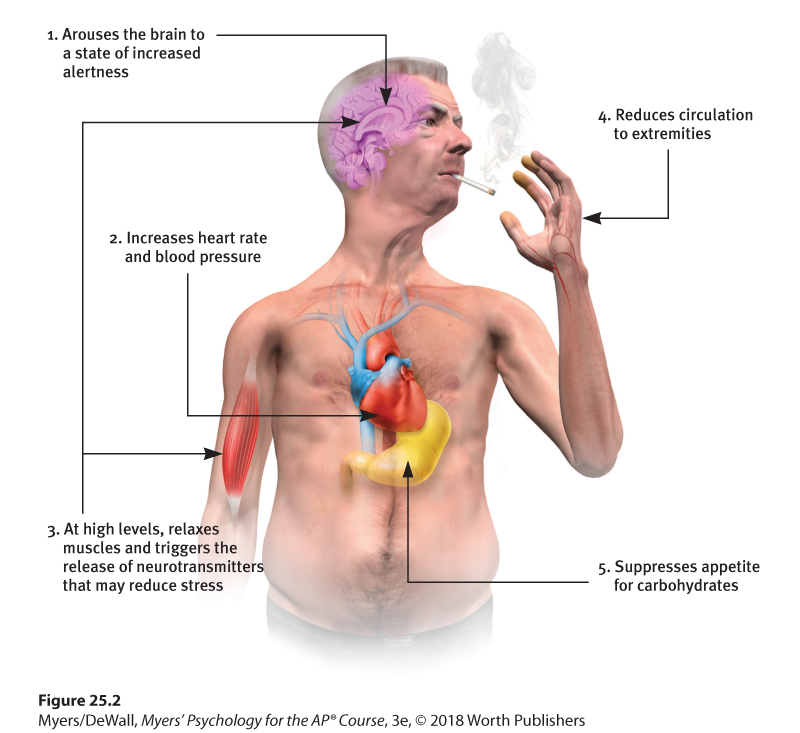
Figure 25.2 Where there’s smoke . . . : The physiological effects of nicotine
Nicotine reaches the brain within 7 seconds, twice as fast as intravenous heroin. Within minutes, the amount in the blood soars.

Nic-A-Teen Virtually nobody starts smoking past the vulnerable teen years. Eager to hook customers whose addiction will give them business for years to come, cigarette companies target teens. Portrayals of smoking by popular actors, such as Scarlett Johansson in Hail, Caesar!, tempt teens to imitate.
These rewards keep people smoking, even among the 3 in 4 smokers who wish they could stop (Newport, 2013). Each year, fewer than 1 in 7 who want to quit will be able to resist. Even those who know they are committing slow-motion suicide may be unable to stop (Saad, 2002). Asked “If you had to do it all over again, would you start smoking?” more than 85 percent of adult smokers have answered No (Slovic et al., 2002).
Nevertheless, repeated attempts seem to pay off. Half of all Americans who have ever smoked have quit, sometimes aided by a nicotine replacement drug and with encouragement from a counselor or support group. Some researchers argue that it is best to quit abruptly — to go “cold turkey” (Lindson-Hawley et al., 2016). Others suggest that success is equally likely whether smokers quit abruptly or gradually (Fiore et al., 2008; Lichtenstein et al., 2010). For those who endure, the acute craving and withdrawal symptoms gradually dissipate over the ensuing six months (Ward et al., 1997). After a year’s abstinence, only 10 percent will relapse in the next year (Hughes, 2010). These nonsmokers may live not only healthier but also happier lives. Smoking correlates with higher rates of depression, chronic disabilities, and divorce (Doherty & Doherty, 1998; Edwards & Kendler, 2012; Vita et al., 1998). Healthy living seems to add both years to life and life to years.
Humorist Dave Barry (1995) recalling why he smoked his first cigarette the summer he turned 15:
“ Arguments against smoking: ‘It’s a repulsive addiction that slowly but surely turns you into a gasping, gray-skinned, tumor-ridden invalid, hacking up brownish gobs of toxic waste from your one remaining lung.’ Arguments for smoking: ‘Other teenagers are doing it.’ Case closed! Let’s light up!”
Cocaine
Cocaine is a powerful and addictive stimulant derived from the coca plant. The recipe for Coca-Cola originally included an extract of that plant, creating a cocaine tonic for tired elderly people. Between 1896 and 1905, Coke was indeed “the real thing.” But no longer. Cocaine is now snorted, injected, or smoked (sometimes as the street drug crack cocaine, a faster-working crystallized form that produces a briefer but more intense high, followed by a more intense crash). It enters the bloodstream quickly, producing a rush of euphoria that depletes the brain’s supply of the neurotransmitters dopamine, serotonin, and norepinephrine (Figure 25.3). Within the hour, a crash of agitated depression follows as the drug’s effect wears off. After several hours, the craving for more wanes, only to return several days later (Gawin, 1991).
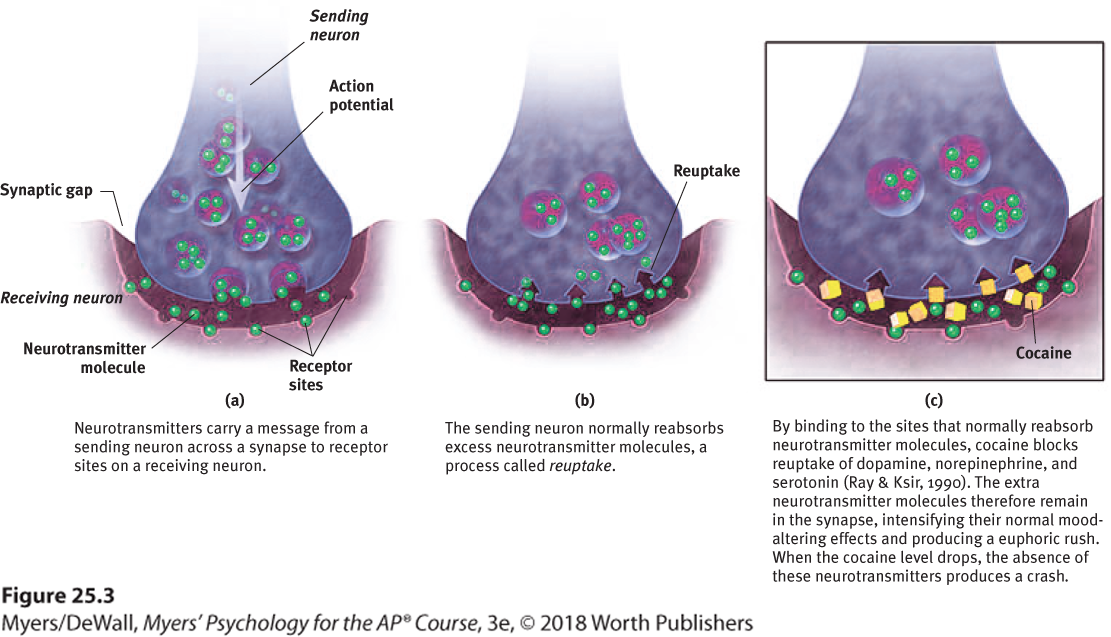
Figure 25.3 Cocaine euphoria and crash
“ Cocaine makes you a new man. And the first thing that new man wants is more cocaine.”
Comedian George Carlin (1937–2008)
In situations that trigger aggression, ingesting cocaine may heighten reactions. Caged rats fight when given foot shocks, and they fight even more when given cocaine and foot shocks. Likewise, humans who voluntarily ingest high doses of cocaine in laboratory experiments impose higher shock levels on a presumed opponent than do those receiving a placebo (Licata et al., 1993). Cocaine use may also lead to emotional disturbances, suspiciousness, convulsions, cardiac arrest, or respiratory failure.
Cocaine’s psychological effects depend in part on the dosage and form consumed, but the situation and the user’s expectations and personality also play a role. Given a placebo, cocaine users who thought they were taking cocaine often had a cocaine-like experience (Van Dyke & Byck, 1982).
In national surveys, 2.5 percent of U.S. high school seniors and 6 percent of British 18- to 24-year-olds reported having tried cocaine during the past year (ACMD, 2009; Johnston et al., 2017). Of those, nearly half had smoked crack.
Methamphetamine
Amphetamines stimulate neural activity. As body functions speed up, the user’s energy rises and mood soars. Amphetamines are the parent drug for the highly addictive methamphetamine, which is chemically similar but has greater effects (NIDA, 2002, 2005). Methamphetamine triggers the release of the neurotransmitter dopamine, which stimulates brain cells that enhance energy and mood, leading to 8 hours or so of heightened energy and euphoria. Its aftereffects may include irritability, insomnia, hypertension, seizures, social isolation, depression, and occasional violent outbursts (Homer et al., 2008). Over time, methamphetamine may reduce baseline dopamine levels, leaving the user with continuing depressed functioning.
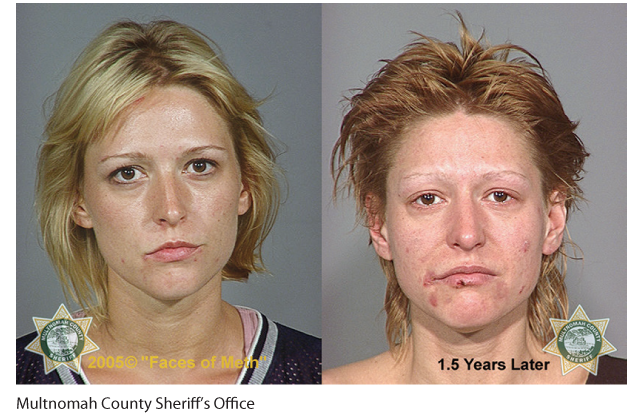
Dramatic drug-induced decline In the 18 months between these two mug shots, this woman’s methamphetamine addiction led to obvious physical changes.

Meth bust As use of the dangerously addictive stimulant methamphetamine has increased, enforcement agencies have increased their efforts to snuff out the labs that produce it.
Ecstasy
Ecstacy, a street name for MDMA (methylenedioxymethamphetamine, also known in its powder form as Molly), is both a stimulant and a mild hallucinogen. As an amphetamine derivative, Ecstasy triggers dopamine release, but its major effect is releasing stored serotonin and blocking its reuptake, thus prolonging serotonin’s feel-good flood (Braun, 2001). Users feel the effect about a half-hour after taking an Ecstasy pill. For 3 or 4 hours, they experience high energy, emotional elevation, and (given a social context) connectedness with those around them (“I love everyone!”).
During the 1990s, Ecstasy’s popularity soared as a “club drug” taken at nightclubs and all-night dance parties (Landry, 2002). The drug’s popularity crosses national borders, with an estimated 60 million tablets consumed annually in Britain (ACMD, 2009). There are, however, reasons not to be ecstatic about Ecstasy. One is its dehydrating effect, which — when combined with prolonged dancing — can lead to severe overheating, increased blood pressure, and death. Another is that long-term, repeated leaching of brain serotonin can damage serotonin-producing neurons, leading to decreased output and increased risk of permanently depressed mood (Croft et al., 2001; McCann et al., 2001; Roiser et al., 2005). Ecstasy also suppresses the immune system, impairs memory, slows thought, and disrupts sleep by interfering with serotonin’s control of the circadian clock (Laws & Kokkalis, 2007; Schilt et al., 2007; Wagner et al., 2012). Ecstasy delights for the night but dispirits the morrow.
Hallucinogens
Hallucinogens distort perceptions and evoke sensory images in the absence of sensory input (which is why these drugs are also called psychedelics, meaning “mind-manifesting”). Some, such as LSD and MDMA (Ecstasy), are synthetic. Others, including the mild hallucinogen marijuana, are natural substances.
Whether provoked to hallucinate by drugs, loss of oxygen, or extreme sensory deprivation, the brain hallucinates in basically the same way (Siegel, 1982). The experience typically begins with simple geometric forms, such as a lattice, cobweb, or spiral. The next phase consists of more meaningful images; some may be superimposed on a tunnel or funnel, others may be replays of past emotional experiences. Brain scans of people on an LSD trip reveal that their visual cortex becomes hypersensitive and strongly connected to their brain’s emotion centers (Carhart-Harris et al., 2016). As the hallucination peaks, people frequently feel separated from their body and experience dreamlike scenes. Their sense of self dissolves, which also dissolves the border between themselves and the external world (Lebedev et al., 2015).
These sensations are strikingly similar to the near-death experience, an altered state of consciousness reported by about 10 to 15 percent of those revived from cardiac arrest (Agrillo, 2011; Greyson, 2010; Parnia et al., 2014). Many describe visions of tunnels (Figure 25.4), bright lights or beings of light, a replay of old memories, and out-of-body sensations (Siegel, 1980). These experiences can later enhance spirituality and promote feelings of personal growth (Khanna & Greyson, 2014, 2015). Given that oxygen deprivation and other insults to the brain are known to produce hallucinations, it is difficult to resist wondering whether a brain under stress manufactures the near-death experience. During epileptic seizures and migraines, people may experience similar hallucinations of geometric patterns (Billock & Tsou, 2012). So have solitary sailors and polar explorers while enduring monotony, isolation, and cold (Suedfeld & Mocellin, 1987). The philosopher-neuroscientist Patricia Churchland (2013, p. 70) surmises that such experiences represent “neural funny business.”
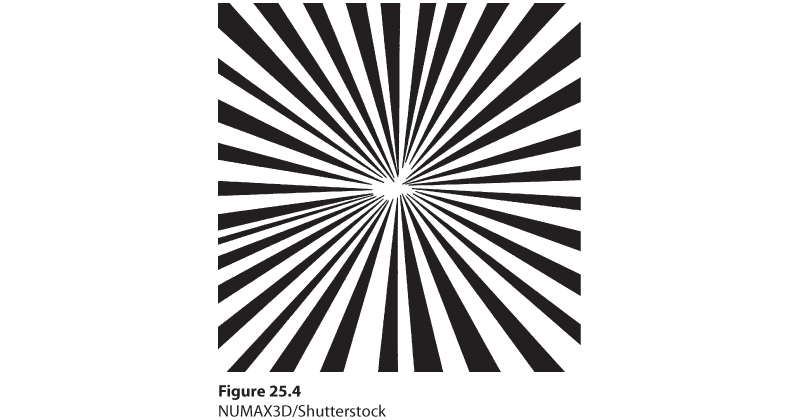
Figure 25.4 Near-death vision or hallucination?
Psychologist Ronald Siegel (1977) reported that people under the influence of hallucinogenic drugs often see “a bright light in the center of the field of vision. . . . The location of this point of light create[s] a tunnel-like perspective.” This is very similar to others’ near-death experiences.
LSD
Albert Hofmann, a chemist, created — and on one Friday afternoon in April 1943 accidentally ingested — LSD (lysergic acid diethylamide). The result — “an uninterrupted stream of fantastic pictures, extraordinary shapes with intense, kaleidoscopic play of colors” — reminded him of a childhood mystical experience that had left him longing for another glimpse of “a miraculous, powerful, unfathomable reality” (Siegel, 1984; Smith, 2006).
The emotions of an LSD (or acid) trip vary from euphoria to detachment to panic. Users’ mood and expectations (their “high hopes”) color the emotional experience, but the perceptual distortions and hallucinations have some commonalities.
Marijuana
The straight dope on marijuana: Marijuana leaves and flowers contain THC (delta-9-tetrahydrocannabinol). Whether smoked (getting to the brain in about 7 seconds) or eaten (traveling at a slower, unpredictable rate), THC produces a mix of effects. Synthetic marijuana (K2, also called Spice) mimics THC. Its harmful side effects can include agitation and hallucinations (Fattore, 2016; Sherif et al., 2016).
Marijuana is usually classified as a mild hallucinogen because it amplifies sensitivity to colors, sounds, tastes, and smells. But like alcohol, marijuana also relaxes, disinhibits, and may produce a euphoric high. Both alcohol and marijuana impair the motor coordination, perceptual skills, and reaction time necessary for safely operating an automobile or other machine. “THC causes animals to misjudge events,” reported Ronald Siegel (1990, p. 163). “Pigeons wait too long to respond to buzzers or lights that tell them food is available for brief periods; and rats turn the wrong way in mazes.”
Marijuana and alcohol also differ. The body eliminates alcohol within hours. THC and its by-products linger in the body for more than a week, which means that regular users experience less abrupt withdrawal and may achieve a high with smaller-than-usual drug amounts. This is the opposite of typical tolerance, in which repeat users need larger doses to feel the same effect.
After considering more than 10,000 scientific reports, the U.S. National Academies of Sciences, Engineering, and Medicine (2017) concluded that marijuana use
- alleviates chronic pain and chemotherapy-related nausea,
- is not associated with tobacco-related cancers, such as lung cancer,
- is predictive of increased risk of traffic accidents, chronic bronchitis, psychosis, social anxiety disorder, and suicidal thoughts, and
- likely contributes to impaired attention, learning, and memory, and possibly to academic underachievement.
A marijuana user’s experience can vary with the situation. If the person feels anxious or depressed, marijuana may intensify the feelings. The more often the person uses marijuana, especially during adolescence, the greater the risk of anxiety, depression, psychosis, or addiction (Bambico et al., 2010; Hurd et al., 2013; Volkow et al., 2016).
Some U.S. states and countries have passed laws legalizing the possession of small quantities of marijuana. Greater legal acceptance may help explain why Americans’ marijuana use nearly doubled between 2013 and 2016, from 7 to 13 percent (McCarthy, 2016).
* * *
Despite their differences, the psychoactive drugs summarized in Table 25.2 share a common feature: They trigger negative aftereffects that offset their immediate positive effects and grow stronger with repetition. This helps explain both tolerance and withdrawal.
| Drug | Type | Pleasurable Effects | Negative Aftereffects |
|---|---|---|---|
| Alcohol | Depressant | Initial high followed by relaxation and disinhibition | Depression, memory loss, organ damage, impaired reactions |
| Heroin | Depressant | Rush of euphoria, relief from pain | Depressed physiology, agonizing withdrawal |
| Caffeine | Stimulant | Increased alertness and wakefulness | Anxiety, restlessness, and insomnia in high doses; uncomfortable withdrawal |
| Nicotine | Stimulant | Arousal and relaxation, sense of well-being | Heart disease, cancer |
| Cocaine | Stimulant | Rush of euphoria, confidence, energy | Cardiovascular stress, suspiciousness, depressive crash |
| Methamphetamine | Stimulant | Euphoria, alertness, energy | Irritability, insomnia, hypertension, seizures |
| Ecstasy (MDMA) | Stimulant; mild hallucinogen | Emotional elevation, disinhibition | Dehydration, overheating, depressed mood, impaired cognitive and immune functioning |
| LSD | Hallucinogen | Visual “trip” | Risk of panic |
| Marijuana (THC) | Mild hallucinogen | Enhanced sensation, relief of pain, distortion of time, relaxation | Impaired learning and memory, increased risk of psychological disorders |
To learn about the influences on drug use, see Module 81.